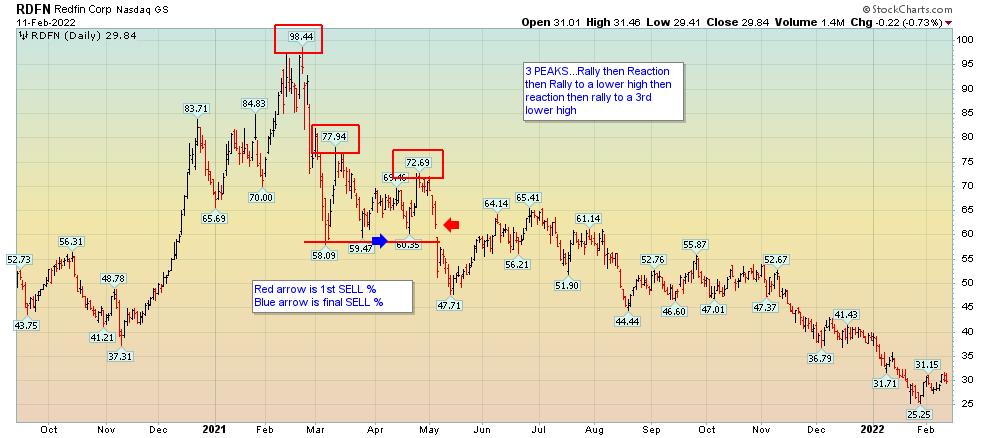Within the stock market, selling profitably is considered an art. In the real world, most folks love art and are happy to talk about it. Institutional investors will talk about the "art of the exit" before they buy an equity. So why is it that individual investors deem it "uncool".
I believe that part of it has to do with the inner struggles most investors experience when it comes to selling their equities. They can't seem to get their own egos out of the way, and they fail to acknowledge their own demons. As Mark Douglas wrote, most investors get wrapped up in some variation of the Four Fears:
- Fear of losing money
- Missing an opportunity
- Leaving money on the table
- Being wrong
Most individual investors perceive themselves as intelligent individuals with muscular money managements skills. Often they've been winners in other arenas of life, and winners are not wired to focus on their losses with a radical candor the markets demand.
Once again, I'm reminded of Charles Darwin's famous quote, "It is not the strongest of the species that survives, nor the most intelligent that survives. It is the one that is most adaptable to change." Your losses require — indeed clamor for — introspective review. I've always envisioned my losses as tuition paid to the University of Wall Street. But God forbid if I pay tuition twice for the same lesson!
There are two ways I deal with my trading losses. The first type of loss is usually the result of the laws of probability, and my methodology expects these. I expect it. I don't like it, but my thinking is that I'll take this small loss and now I'm one step closer to my next big gainer.
The second type of loss is altogether something else. Losses that result from ignoring my trading plan or my selling disciplines and thereby falling into some bad behaviors of human nature requires serious introspection and brutal self-honesty. I know better. And I know I mustn't let it happen again.
So now building upon all these foundations learned from the Dennis Rodman defensive basketball metaphor (Part 1) to embracing the "Investor Self", how did you make out with the selling role-play in last week's blog with respect to Redfin (RDFN), 1 Life Healthcare (ONEM) and Pinterest (PINS)?
I heard from a number of you who felt this was an extremely valuable exercise. In fact, in the two-day Stock Market Mastery seminars that Grayson and I taught before the pandemic (and hope to do so again), we'd spend hours on the three stages dealing with Exit Strategies and Selling disciplines (i.e. Stage #3 -The Investor Self; Stage #8 - Monitoring; Stage #9 - Selling). As homework, attendees were asked to paper trade 50 equities and execute their selling methodologies. The comprehension and absorption were immediate. Yes, the cliche applies: "practice makes perfect".
In a spirit of full disclosure, I've decided to make this a three-part blog. Candidly, my motivation is threefold.
- I benefit from revisiting my own exit disciplines.
- Acquiring the skills necessary to execute timely sells is an extremely high-leverage activity and produces consistent profits. It warrants the effort.
- For those readers who are truly committed to up their investing game, I'd like to help facilitate that with a bit more foundation building — which I call homework. So here's the Game Plan. Before I present Part 3 of this series, I challenge you to execute the following curriculum:
- Paper trade 50 equities from your past investment or pick 50 from the StockCharts.com scan list of new lows. Apply the three peaks sell methodology and then apply your personal exit strategy.
- Read the three chapters in our book which I listed above.
- Review some of the 13 Traders Journal Blogs that I've written and archived under Stage #9 - Selling.
- Watch this short video clip of the famous scene from the movie "A Few Good Men" where Tom Cruise demands Jack Nicholson tell him the truth. Colonel Jessup (Nicholson) responds with radical candor: "You can't handle the truth....etc." It's a flawless parallel to the stock market. The markets talk to you truthfully each day. Are you able to hear, accept and act upon those truths? Find a mirror. Stare into it. Say to yourself, "I can now handle the truth — give it to me!!"
If you do these four steps, you'll be ready for Part 3 of Sushi Investing. In the meantime, here is our three-peaks "basic" selling methodology. Back test it on your own past trades. Don't let its simplicity fool you. That's its strength. When you see the three peaks, you know how and when to sell. Then it's merely having the discipline to pull the trigger.



Trade well; trade with discipline!
Gatis Roze, MBA, CMT
- Author, "Tensile Trading: The 10 Essential Stages of Stock Market Mastery" (Wiley, 2016)
- Developer of the "Stock Market Mastery" ChartPack for StockCharts members
- Presenter of the best-selling "Tensile Trading" DVD seminar
- Presenter of the "How to Master Your Asset Allocation Profile DVD" seminar
Trade well; trade with discipline!
Gatis Roze, MBA, CMT
- Author, "Tensile Trading: The 10 Essential Stages of Stock Market Mastery" (Wiley, 2016)
- Developer of the "Stock Market Mastery" ChartPack for StockCharts members
- Presenter of the best-selling "Tensile Trading" DVD seminar
- Presenter of the "How to Master Your Asset Allocation Profile DVD" seminar






